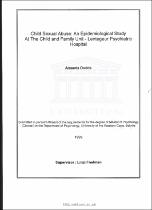| dc.contributor.advisor | Fredman, Linzi | |
| dc.contributor.author | Dodds, Amanda | |
| dc.date.accessioned | 2022-10-10T11:21:43Z | |
| dc.date.available | 2022-10-10T11:21:43Z | |
| dc.date.issued | 1999 | |
| dc.identifier.uri | http://hdl.handle.net/11394/9348 | |
| dc.description | Magister Psychologiae - MPsych | en_US |
| dc.description.abstract | Across international and local epidemiological studies of child sexual abuse, two aspects of the literature have remained empirically consistent. Many more girls are sexually abused than boys and most perpetrators are male. Of all theoretical models of child sexual abuse, feminist theories offer the most comprehensive explanations for the gender bias found in child sexual abuse literature. ln this regard, feminist explanations for child sexual abuse have been explored and used to interpret the results of this research. The current study aimed to describe the epidemiology of child sexual abuse at the Child and Family Unit (CFU) of Lentegeur Hospital using a retrospective descriptive study design. 241 case records were reviewed to determine the prevalence of child sexual abuse. Data was collected concerning: services emographics; presenting symptoms; nature and duration of abuse; risk factors; perpetrator characteristics; legal action and service utilisation of CFU. Results were analysed using the Fishe/s Exact Test and the Wilcoxon 2 - Sample Test. P< 0.05 was used to indicate statistical significance while cross tabulations were used for descriptive associations. Results revealed a 23.7o/o prevalence rate of child sexual abuse, which was lower than other clinically based studies. This finding was not understood to reflect an actual low prevalence of child sexual abuse, but rather a lower service utilisation of the Unit by sexually abused children. Girls were seven times more likely to present at the Unit with child sexual abuse than boys. Children presented with an array of symptoms, difficulties at school occurring the most frequently. Most perpetrators were male, usually a person known to the victim (neighbour or a peer) or an extended family member (usually an a uncle). Rape and sexual molestation were the most common types of abuse experienced. Most subjects presented at the Unit a year after the sexual abuse had ended. Overall, services offered at CFU were poorly utilised by sexually abused children, most subjects attended only.
one session at the Unit and did not return for further intervention. Findings suggest that a protocol for the management of child sexual as well as an evaluation of services offered at CFU is currently necessary. | en_US |
| dc.language.iso | en | en_US |
| dc.publisher | University of the Western Cape | en_US |
| dc.subject | Child and Family Unit (CFU) | en_US |
| dc.subject | Epidemiological | en_US |
| dc.subject | Women's Liberation movement (WLM) | en_US |
| dc.subject | Lentegeur Hospital | en_US |
| dc.subject | Data | en_US |
| dc.subject | Psychiatric | en_US |
| dc.title | Child Sexual Abuse: An Epidemiological Study At The Child and Family Unit - Lentegeur Psychiatric Hospital | en_US |
| dc.rights.holder | University of the Western Cape | en_US |

